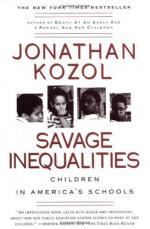
|
| Name: _________________________ | Period: ___________________ |
This test consists of 15 multiple choice questions and 5 short answer questions.
Multiple Choice Questions
1. What does the New York Times say the better public schools are intended to do?
(a) Give the rich an alternative to high-priced private schools.
(b) To serve as academic school.
(c) Attract or skim off the more privileged children.
(d) To uphold the school system's high academic standards.
2. According to the principal, how much does Woodrow Wilson spend yearly on each student?
(a) $2,000.
(b) $4,000.
(c) $3,000.
(d) $5,000.
3. What does the Wall Street Journal say has remained static while per-pupil spending has increased?
(a) Teacher retention rates.
(b) The dropout rate.
(c) Student attendance.
(d) Student achievement.
4. According to Kozol, what is the estimated worth of the education a child receives in the inner city of New York?
(a) $5,000.
(b) $4,000.
(c) $4,500.
(d) $5,500.
5. Who used to attend the church in Camden that Kozol passes while chatting with two teachers from Camden High School?
(a) Walt Whitman.
(b) Robert Frost.
(c) Martin Luther King, Jr.
(d) Langston Hughes.
6. Why did the city of Chicago construct the high-speed Dan Ryan Expressway to go around certain parts of the city?
(a) To avoid sections of the city that were not highly populated.
(b) To cut off the section of the city that houses the housing projects for black people.
(c) To cut off the industrial sections of the city.
(d) To only service those living in the suburbs, but working in downtown Chicago.
7. What is the race of the non-white children in the accelerated classes at the school in Riverdale?
(a) Black.
(b) Asian.
(c) Hispanic.
(d) African.
8. What does John Coons of the University of California, Berkeley say all children technically are?
(a) Poor.
(b) Educated.
(c) Obedient.
(d) Rich.
9. What types of courses does the principal at Woodrow Wilson High School say he is unable to provide his students?
(a) Remedial courses.
(b) Honors courses.
(c) Online courses.
(d) AP courses.
10. Who said that Americans allow all of their children the things they need to compete at the highest levels of success?
(a) Queen Elizabeth.
(b) Langston Hughes.
(c) Martin Luther King.
(d) Lord Acton.
11. According to Delabian Rice Thurston, where do the rich in Washington, D.C. try to send their children?
(a) Public school.
(b) Catholic school.
(c) Boarding school.
(d) Private school.
12. How many students attend Camden High School?
(a) 3,000.
(b) 2,000.
(c) 4,000.
(d) 1,000.
13. What term does the principal at Camden High School give to the dividing up of the children based on their previous test results?
(a) Selective grouping.
(b) Homogeneous grouping.
(c) Heterogeneous grouping.
(d) Random selection.
14. What type of early child care program can the principal at PS79 not start at his school?
(a) Morning kindergarten.
(b) Even State program.
(c) Head Start program.
(d) Pre-kindergarten.
15. What is one way Jonathan Kozol says can show people how valuable we think they are?
(a) By the number of social workers assigned to a school.
(b) By the medical care we offer them.
(c) By the amount of welfare they receive.
(d) By the textbooks that are in the classrooms at the school.
Short Answer Questions
1. Why did Kozol stay in Cherry Hill while he was visiting Camden?
2. What is the fate of Raymond Abbot long after the court's decision is rendered?
3. According to Kozol, what statistic does New York find hard to track?
4. According to Kozol, what does the city of New York supply each ghetto school with?
5. Where do most of the motivated children at Morris High School plan to go after they graduate?
|
This section contains 628 words (approx. 3 pages at 300 words per page) |

|




